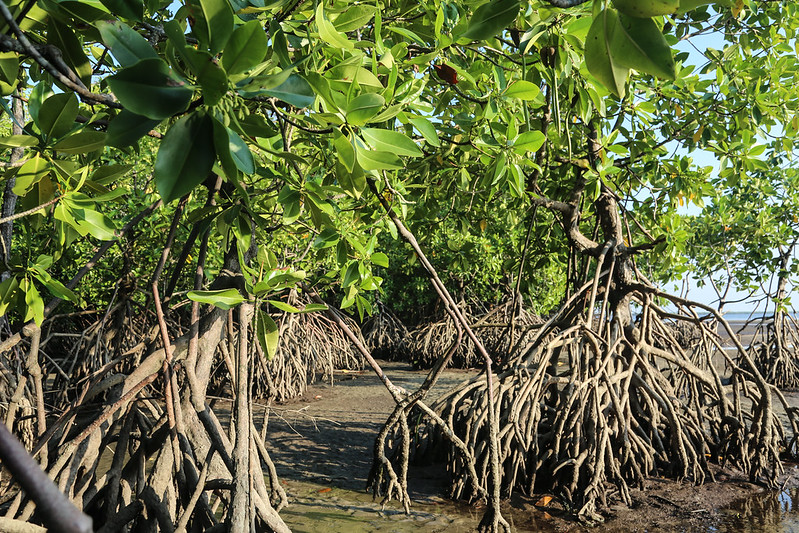More than half of all mangrove ecosystems at risk of collapse by 2050, first global assessment finds
Gland, Switzerland, 22 May 2024 (IUCN) – More than half of the world’s mangrove ecosystems are at risk of collapse, according to the first global mangrove assessment for the International Union for Conservation of Nature (IUCN) Red List of Ecosystems.

Mangroves provide extensive services for nature and people
This is the first time an ecosystem group has been assessed entirely across the planet using the IUCN Red List of Ecosystems – a global standard for measuring the health of ecosystems.
Released today on the International Day for Biodiversity, the findings show that 50% of the mangrove ecosystems assessed are at risk of collapse (classed as either Vulnerable, Endangered, or Critically Endangered*).
According to the assessment, nearly 20% (19.6%) of the assessed mangroves are at high risk, classed as either Endangered or Critically Endangered, reflecting these areas are at severe risk of collapse.
Mangroves are threatened by deforestation, development, pollution, and dam construction, but the risk to these ecosystems is increasing due to sea-level rise and the increased frequency of severe storms associated with climate change. Climate change threatens one third (33%) of the mangrove ecosystems assessed.
“IUCN’s Red List of Ecosystems is key to tracking progress towards the goal of halting and reversing biodiversity loss, in line with the Kunming-Montreal Global Biodiversity Framework. The first global assessment of mangrove ecosystems gives key guidance that highlights the urgent need for coordinated conservation of mangroves – crucial habitats for millions in vulnerable communities worldwide. The assessment’s findings will help us work together to restore the mangrove forests that we have lost and protect the ones we still have,” said Dr Grethel Aguilar, IUCN Director General.
This study classified the world’s mangrove ecosystems in 36 different regions called provinces (delineated areas where mangroves exist indicated in the below map) and assessed the threats and risk of collapse in each region. This work has been led by IUCN, with active involvement of more than 250 experts based in 44 countries, coming from various research institutions including the IUCN Commission on Ecosystem Management, IUCN Species Survival Commission, and Global Mangrove Alliance.
“Mangrove ecosystems are exceptional in their ability to provide essential services to people, including coastal disaster risk reduction, carbon storage and sequestration, and support for fisheries. Their loss stands to be disastrous for nature and people across the globe. That is why this assessment is so important. The Red List of Ecosystems provides clear pathways on how we can reverse mangroves loss and protect these delicate ecosystems for the future, helping in turn to safeguard biodiversity, tackle the effects of climate change and support the realisation of the Global Biodiversity Framework,” said Angela Andrade, Chair of IUCN Commission on Ecosystem Management.
 The global mangrove areas are depicted above
Photo: IUCN
The global mangrove areas are depicted above
Photo: IUCN
According to the assessment, without significant changes by 2050, climate change and sea level rise will result in the loss of:
- 1.8 billion tonnes of carbon stored (17% of the total current carbon stored in mangroves), currently valued at a minimum of $13 billion at market prices in voluntary carbon markets and representing a cost to society equal to $336 billion based on the social cost of carbon.
- protection for 2.1 million lives exposed to coastal flooding (14.5% of current lives exposed) and $36 billion worth in protection to properties (35.7% of current property values protected)
- 17 million days of fishing effort per year (14% of current fishing effort is supported by mangroves).
The assessment finds that maintaining mangrove ecosystems across the globe will be key for mitigating the impacts of climate change, with healthy mangroves able to better cope with sea level rise and offering inland protection from the impacts of hurricanes, typhoons and cyclones.
A headline indicator for Kunming Montreal Global Biodiversity Framework, the Red List of Ecosystems is a useful tool for combating global biodiversity loss. The results of this study, which identifies the main contributing factors behind mangrove degradation, can help guide future national assessments and actions to protect and restore these delicate ecosystems. The assessment will also be a vital part of the realisation of global commitments like the Mangrove Breakthrough, which aims to secure the future of 150,000 km2 of mangroves.
The assessment finds that maintaining ecosystem integrity will help mangroves withstand climate change impacts. Preserving existing mangrove forests, and restoring lost areas, for example, will increase their resilience. Maintaining sediment flows, and allowing space for mangroves to expand inland, helps mangroves cope with sea level rise. Stakeholders can look at information included in Red List of Ecosystems assessment to identify the most pressing threats in their region and select the best restoration options.
Established in 2014, the Red List of Ecosystems (RLE) is a global standard for how we evaluate the conservation status of environments, applicable at local, national, regional, and global levels. It acts as a tool for assessing and monitoring the ‘health’ of global ecosystems, the threats these environments face and ways to reduce risks to and loss of biodiversity.
It compliments other biodiversity tools offered by IUCN such as the Red List of Threatened Species, the World Database on Protected Areas and the World Database of Key Biodiversity Areas.
* There are eight categories of risk for each ecosystem. These are: Not Evaluated (NE), Data Deficient (DD), Least Concern (LC), Near Threatened (UNT), Vulnerable (V), Endangered (EN), Critically Endangered (CR), and Collapsed (CO). More information on the categorisation process is here.
